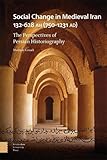Social Change in Medieval Iran 132-628 AH (750-1231 AD) : The Perspectives of Persian Historiography / Maryam Kamali.
Material type: TextPublisher: Amsterdam : Amsterdam University Press, [2023]Copyright date: 2023Description: 1 online resource (282 p.)Content type:
TextPublisher: Amsterdam : Amsterdam University Press, [2023]Copyright date: 2023Description: 1 online resource (282 p.)Content type: - 9789048556304
- 955.0072 23
- online - DeGruyter
| Item type | Current library | Call number | URL | Status | Notes | Barcode | |
|---|---|---|---|---|---|---|---|
 eBook
eBook
|
Biblioteca "Angelicum" Pont. Univ. S.Tommaso d'Aquino Nuvola online | online - DeGruyter (Browse shelf(Opens below)) | Online access | Not for loan (Accesso limitato) | Accesso per gli utenti autorizzati / Access for authorized users | (dgr)9789048556304 |
Frontmatter -- Table of Contents -- Preface -- Introduction -- Author’s Notes -- Part I The Formation of Iranian Authority under the ʿAbbāsid Caliphate -- Introduction -- 1 The Formation of the ʿAbbāsid Caliphate. -- 2 Establishment of the ʿAbbāsid Caliphate -- 3 Split in the ʿAbbāsid Political Structure -- Part II The Structure of Iranian Dynasties. From Dependence to Independence -- Introduction -- 4 The Rule of the Tāherids in the Shadow of the ʿAbbāsid Caliphate -- 5 The Structure of the Sāmānid Government. Moving in the Direction of Cultural Independence -- 6 The Saffārid Dynasty . A Power outside the ʿAbbāsid Structure -- 7 The ʿAlawites of Tabarestān, the First Shiʿite Dynasty in Iran -- 8 The Buyid Dynasty . A Turning Point in Iran’s Social Change -- Part III The Rise of Soltānates in the Power Structure -- Introduction -- 9 The Formation of the Ghaznavid Soltānate -- 10 The Saljuq Dynasty . The First Islamic Empire in Iran -- 11 The Khwārazmshāhi Dynasty: Emerging from the Saljuq Structure -- Conclusion -- Bibliography -- Index
restricted access online access with authorization star
http://purl.org/coar/access_right/c_16ec
This study contributes to the history of social changes in Iran during the Abbasid Caliphate (AH 132–656, AD 750–1258) by foregrounding the perspective of Persian language historians – from Abu Ali Bal'ami (AH 363, AD 974), the first known Persian historian, to Atamelak Joveyni (AH 623–681, AD 1226–1283), the great historian of the Mongol Era. By applying the insights of Anthony Giddens and the theory of structuration to address the interactions of social agents and structures, this book provides a coherent narrative of social transformation in medieval Iran.
Mode of access: Internet via World Wide Web.
In English.
Description based on online resource; title from PDF title page (publisher's Web site, viewed 26. Aug 2024)


